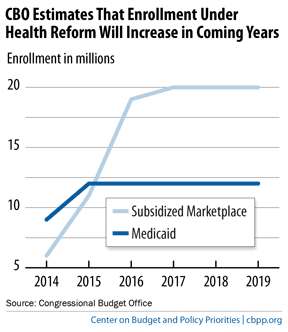BEYOND THE NUMBERS
The Administration is expected to issue estimates this week of enrollment since October 1 in health reform’s Medicaid expansion and its new health insurance marketplaces — and some media have already reported that the numbers did not meet Administration expectations. But, as we’ve learned by examining the early experience with the Children’s Health Insurance Program (CHIP), early enrollment numbers aren’t a reliable indicator of health reform’s long-term performance.
CHIP — now recognized as an undeniable success — started slowly, too. When the program started in fiscal year 1998, only eight states began enrolling low-income children in the first quarter. By the end of that year, only 29 states operated CHIP programs and more than half of the 665,000 children enrolled came from just three states where most of the enrollment involved children transferred to CHIP from their pre-CHIP, state-funded children’s health programs.
But, by the end of fiscal year 2000, all 50 states and the District of Columbia had used CHIP to expand health insurance coverage to more low-income children, and enrollment had reached 3.3 million children. Growing steadily ever since, CHIP now provides health insurance coverage to 8.1 million children.
The Congressional Budget Office (CBO) has estimated that health reform’s coverage expansions will eventually lead to 12 million to 13 million more people enrolled in Medicaid (and CHIP) and to about 20 million people enrolled in subsidized marketplace coverage. But, these results will be achieved over time. For example, steady-state enrollment won’t come in Medicaid until 2015 and in the marketplaces until 2017, CBO estimates (see chart). (The coverage gains will be larger than this if most or all states ultimately adopt health reform’s Medicaid expansion for low-income non-elderly adults.)

Similar to states’ experiences with CHIP, it will likely take several years — as well as sustained, cooperative efforts by states, the federal government, and stakeholders — to maximize that enrollment. (An analysis from First Focus similarly concludes that CHIP’s early years show that it likely will take considerable time for health reform to achieve major coverage gains.)
We can’t measure health reform’s success solely on the first month or first few months of enrollment numbers — or even on all of 2014 — just as CHIP couldn’t be judged based on its first year’s modest enrollment. Rather, as with CHIP, it will take several years of experience to accurately evaluate health reform’s coverage expansions.
Click here to read the full paper.
